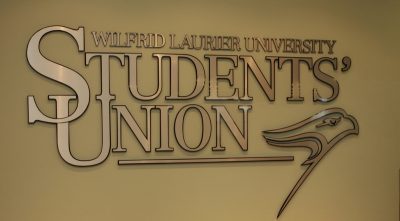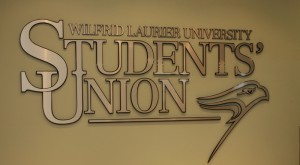WLUSU runs up over $4 million in debt to Laurier


According to the 2012 Wilfrid Laurier University Students’ Union auditor’s report — which compares their financial data from April 30, 2011 to April 30, 2012 — the Students’ Union, without the current liabilities included, owes a debt load of $4,250,156 to the university.
WLUSU currently owes the university one loan of $1, 902, 855 while also still owing the university a figure of $2, 347, 301 for a different loan. In addition, the Students’ Union has two external non-revolving long-term loans that total about $2.4 million in 2012, which are secured through a guarantee of $3 million from the university.
The report outlines that WLUSU will have to make a payment of $233, 979 for their long-term debt in 2013 — which includes the $1.9 million loan from WLU — and will also make a payment of $118,000 this year towards the other loan from the university, which totals $2.3 million.
According to the report, WLUSU was “not in compliance with certain of its lending covenants with the university” as of April 30, 2012 for the loan of around $2.3 million and the university and the union then “reached an agreement to waive the covenant breach.” As a result, the Students’ Union makes annual payments on that particular loan.
However, according to Jim Butler, the vice-president of finance at WLU, the loan agreement that the university has with WLUSU has a cap of $5 million. This number includes both money the university loans to the Students’ Union and the $3-million guarantee on outside loans.
According to Butler, WLUSU has exceeded that limit.
“They are in excess of the $5 million agreement,” Butler confirmed. “We’re working with them to bring it back down…. We’re working with them to help them with their cash flow on that.”
2012-13 WLUSU president and CEO, Michael Onabolu, addressed some of the questions asked by The Cord in regards to the public auditor’s report. The report was signed off by the auditors on Jan. 31,2013, and subsequently uploaded onto WLUSU’s website.
“We always monitor our financial situation, constantly, especially this year. We obviously have a plan to mitigate be within that cap,” he explained. “We’re at a point where we don’t have a lot of wiggle room before the cap. So when you’re in a position like that, you’re not able to take on things like capital projects and different things that we would’ve done in the past.”
Onabolu, however, did not speak about many specifics since it’s an on-going discussion WLUSU is having within their administration through in-camera, private meetings within their board meetings. When asked if WLUSU – of which all undergraduates are members – is going to be communicating any information with the students in the near future Onabolu said, “There’s definitely an intention to communicate with students.”
Onabolu declined to comment when asked if this forthcoming information had to do with finances.
While the in-camera sessions aren’t entirely always financial matters, WLUSU board chair and chief governance officer, Jon Pryce, confirmed the board and management team have been discussing financial matters within in-camera sessions for 2012-13.
“We’ve been dealing with a lot of stuff in camera because there has been a lot of confidential stuff in terms of finances,” Pryce said. “We couldn’t have that outside of in camera because the problem is if you discuss something outside of in camera, and it’s not confirmed or hasn’t been established fully yet, problems could arise.”
Pryce noted that the increase of in-camera sessions during board meetings this year has also been due to the weekly board evaluations as an attempt to create a more comfortable environment for the directors.
When asked if financial matters are typically dealt within in camera, Pryce responded by saying, “Not really, this was more so with the auditors and some of the financial conditions that we have, and the university. We’re just trying to get those terms sorted out. A lot of them are basic updates, [such as] getting the board’s opinion.”
“It was not unexpected, and that’s what I can say,” said Jordan Epstein, the vice-chair for this year’s board and the incoming chair and CGO for next year’s board, about the auditor’s report. Part of his mandate for next year is making the board more transparent.
“That’s sort of what I’m getting at with the transparency thing. That’s not a human resource situation, it’s not a contract [issue],” Epstein said about discussing finances in camera. Epstein, because of the confidentially of the financial matters and the in-camera sessions, declined to discuss any specifics in regards to the financial matters.
The recently released report, which was audited by KPMG Chartered Accountants, also outlined a drop in total revenue of 54 per cent. 2012 saw WLUSU’s total revenues fall from $14,497,956 in 2011 to $7,890,159 in 2012, something that Onabolu attributes to the closing of Wilf’s due to flooding in late 2011 and the separation of the Student Life Levy fees that used to flow through WLUSU’s operating dollars.
Roly Webster WLUSU’s executive director, who started in his position in December, expressed some concern with the 2012 auditor’s statement.
“I want them [the numbers] to be better than that, [but] I’m not concerned that they’re going to impact the organization,” he explained. “Let’s better those numbers faster so we’re be able to do some other things.”
“We’re going through a budget process right now, and where we can tighten up is on the budget side,” Webster said, noting that this situation should not impact the services they annually provide students.
Pryce, Onabolu and Webster all claimed that the point of the in-camera sessions this year was not to hide important information for the students. Instead the sessions have been used as a precaution taken by WLUSU.
“We wouldn’t go into in camera if it wasn’t absolutely necessary,” said Onabolu.
Webster echoed Onabolu’s remarks, “Our goal is to always be transparent with the students…and in-camera sessions doesn’t mean we don’t want to communicate with students.”

